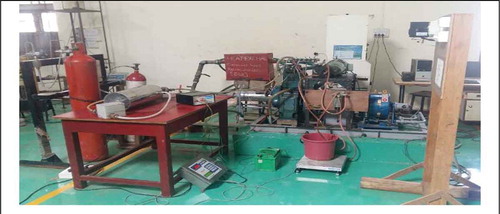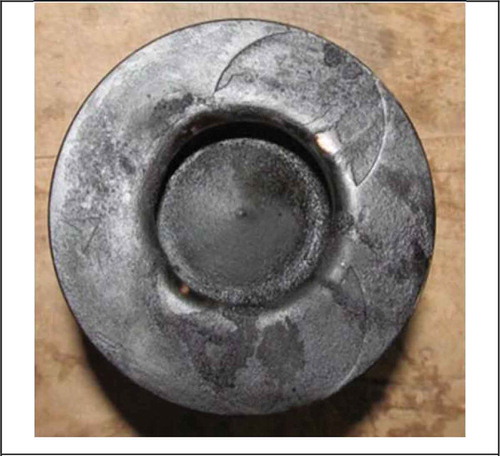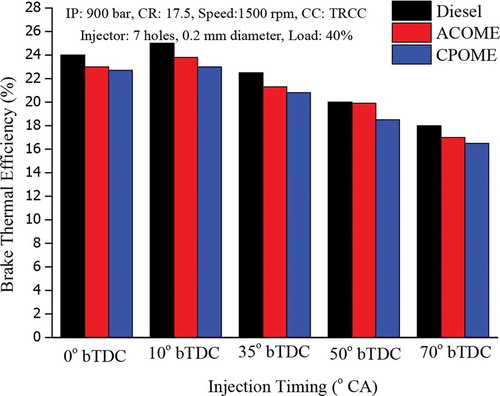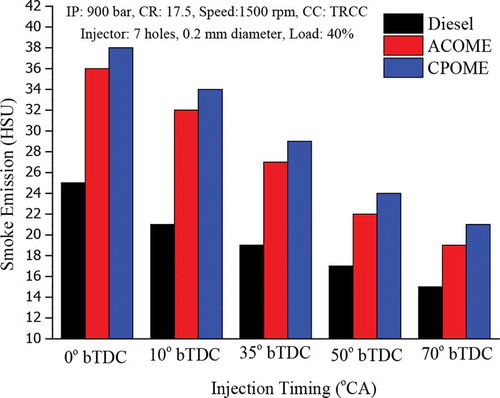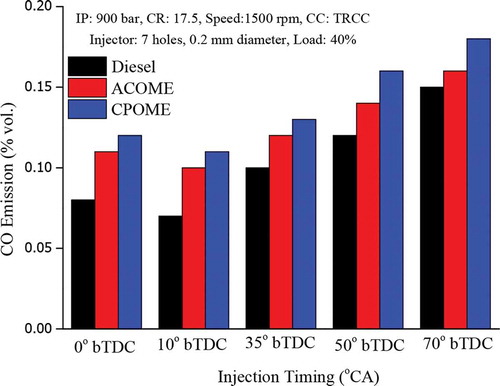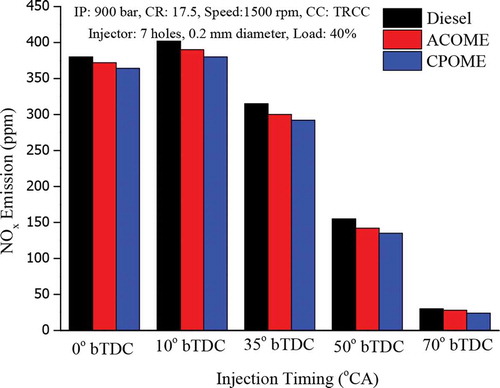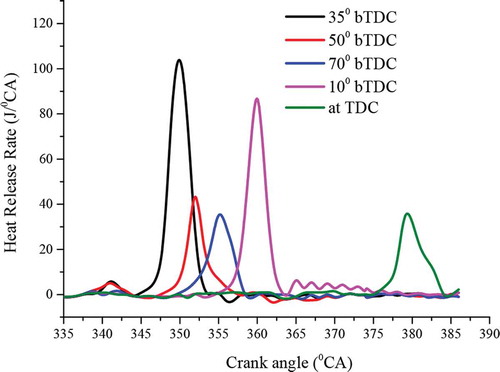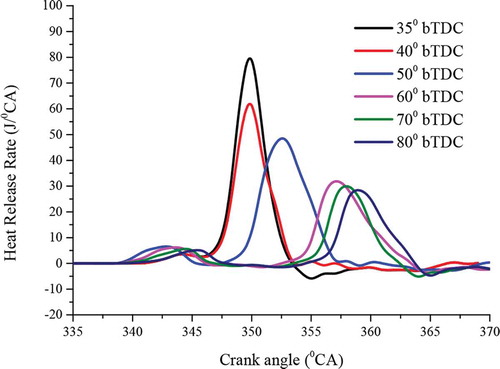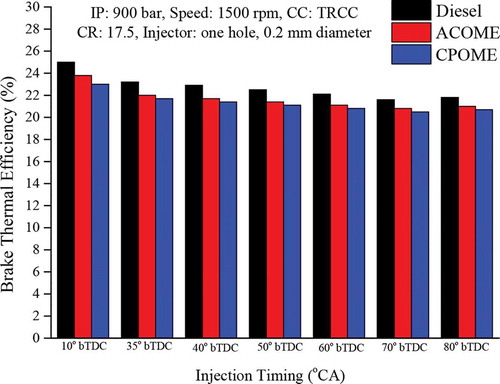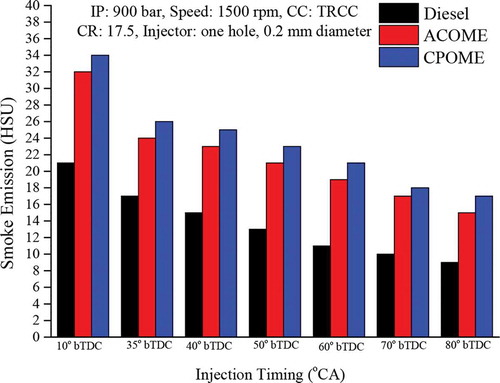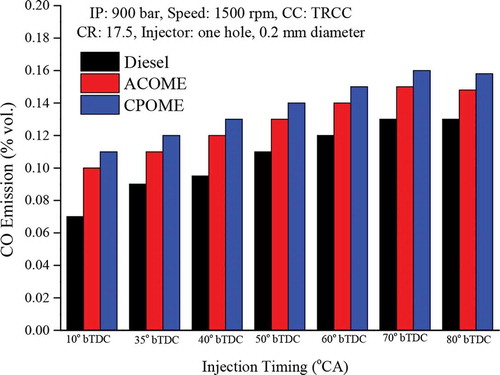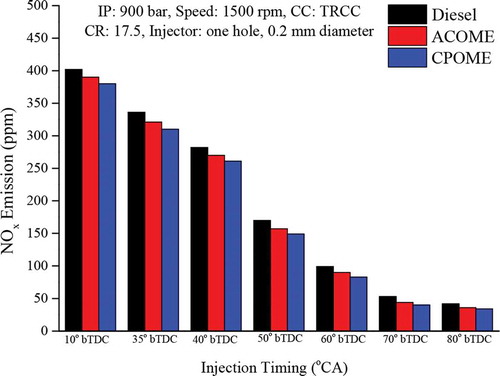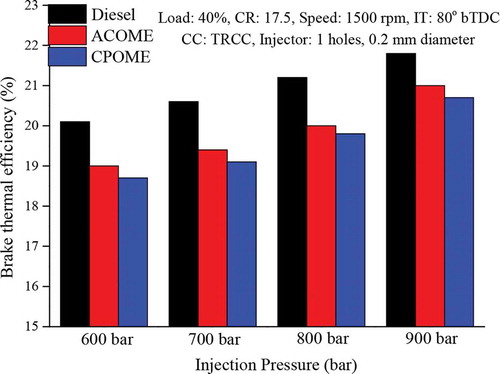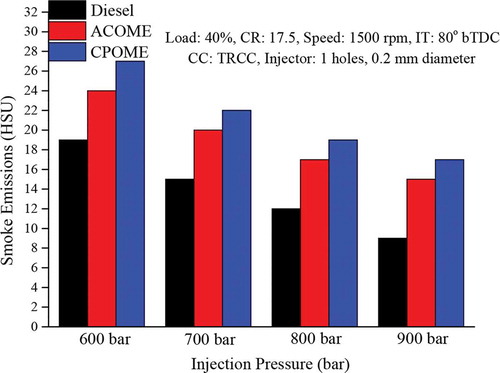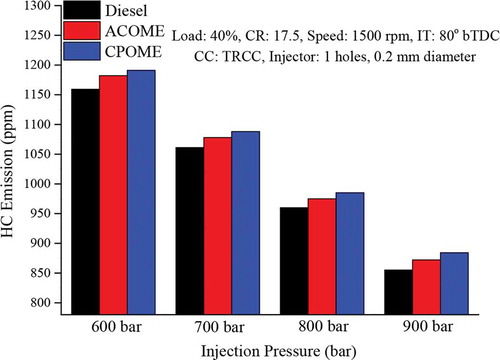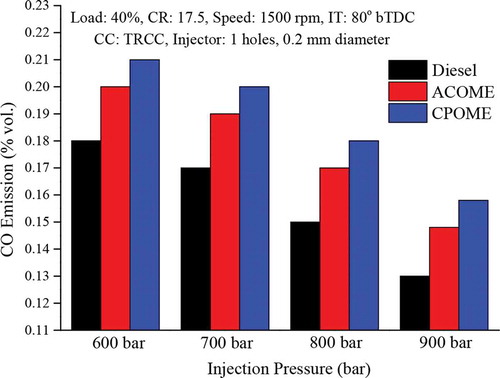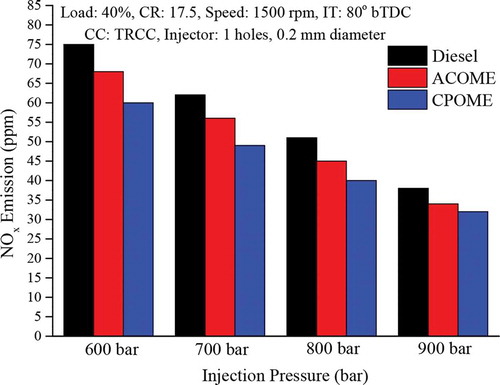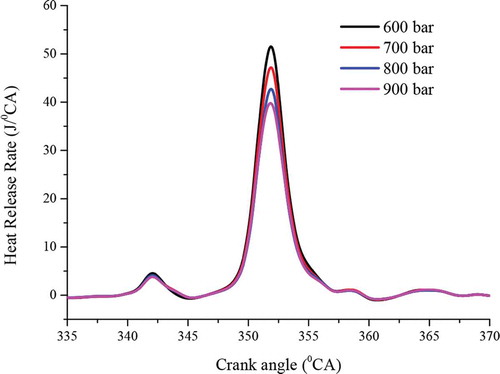ABSTRACT
Experimental tests were performed on homogeneous charge compression ignition (HCCI) with in-cylinder direct injection (DI) of diesel, biodiesel of Ceiba Pentandra oil methyl ester (CPOME) and biodiesel of Acid oil methyl ester (ACOME). Initially some trial experiments were conducted at different fuel injection timing (IT) to distinguish the HCCI operation from common rail direct injection (CRDI) operation. For this, heat release rate (HRR) analysis, trial experiments were conducted for 40 % Load. The cool flame always started at about 20° before top dead centre (bTDC) showing HCCI operation started with fuel IT advancement of 50° bTDC and more. HCCI engine showed lowered peak HRR and retarded one. Higher injection pressure (IP) lowered oxides of nitrogen (NOx) due to lower HRR. NOx of 42 ppm, 36 ppm and 34 ppm were achieved with diesel, ACOME and CPOME respectively at IP 900 bar and IT of 80° bTDC in HCCI mode. Lower smoke of 9 HSU, 15 HSU and 17 HSU was achieved with diesel, ACOME and CPOME respectively at the same operating conditions. Overall, it could be concluded that, IP 900 bar and IT of 80° bTDC are the best operating conditions to reduce NOx and smoke with slightly lower brake thermal efficiency (BTE) in HCCI mode.
1. Introduction
Diesel engines are highly efficient in terms of fuel economy but produce dangerous oxides of nitrogen (NOx) and smoke emissions. Compression ignition (CI) engine are compatible besides with biodiesel besides better performance. To meet the emission norms of regulatory bodies, use new concepts is needed. Homogeneous charge compression ignition (HCCI) is the one such concept that started during the late 1970. In HCCI engines, charge formed auto-ignites on reaching chemical activation energy. Combustion advance could be avoided with 200°C intake temperature and low CR (less than 8) in HCCI engine besides very low NOx and smoke but hydrocarbon (HC) emission was high resulting in non-optimal combustion phasing. Reduction in brake thermal efficiency (BTE) by 28% as compared to conventional CI mode has been reported (Christensen, Hultqvist, and Johansson Citation1999; Mingfa, Zhaolei, and Liu Citation2009). The intake manifold injection showed very early combustion phasing at higher CR and load besides, higher HC, poorer BTE and sever knocking. HCCI operation with methyl-tertiary-butyl ether (MTBE) and diesel (50:50) showed combustion phasing near to TDC because of delayed auto ignition (Suzuki, Koike, and Odaka Citation1998). HCCI engine yielded very low NOx and smoke with higher HC and CO. Slightly lower BTE and specific fuel consumption (SFC) were also reported (Kumar et al. Citation2013). HCCI engine at 120° before top dead centre (bTDC) fuel injection timing (IT) with multi-hole injector of small diameter yielded 8000 ppm HC and very early combustion phasing (Takeda and Keiichi Citation1996; Nakagome et al. Citation1997). HCCI engine with split injection showed premature ignition, very high CO, HC and lower NOx (Yokota et al. Citation1997; Suzuki et al. Citation1997). Spray angle of 80° and IT of 40–60° bTDC showed very high smoke and 1000 to 2500 ppm HC but higher SFC than diesel mode (Iwabuchi et al. Citation1999).
Toroidal combustion chamber (TCC) showed no change in smoke but yielded lower NOx and HC (Kimura et al. Citation1999, Citation2000). Multiple injection of fuel showed higher NOx but HC and CO found lower (Morita et al. Citation2000; Nishijima, Asaumi, and Aoyagi Citation2002). A narrow spray cone angle injector employed HCCI engine showed higher BTE than CI mode (Walter and Gatellier Citation2003).
High negative valve overlap (NVO) produced lower NOx and smoke at low loads with good combustion stability. Higher NOx due to knocking combustion and higher pressure rise rates were reported at higher loads (Shi, Deng, and Cui Citation2005). HCCI engine run with multiple injections lowered smoke and NOx. Proper mixing enhanced CC design could be the reason reported (Su, Zhang, and Lin Citation2004).
Early in cylinder injection could operate the HCCI engine at lower BMEP range (2.1–4.3 bar) and lower NOx and poor BTE were seen (Nathan Swami, Mallikarjuna, and Ramesh Citation2007).
To reduce NOx, high-pressure loop exhaust gas recirculation (EGR) without cooler and variable valve timing (VVT) could be better option (Bression et al. Citation2008). Optimisation of fuel IT is important in avoiding knocking combustion (Harada et al. Citation1998; Hashizume et al. Citation1998; Odaka et al. Citation1999). Speed, load and internal EGR increased the occurrence probability of knocking but higher external EGR reduced it (Lei et al. Citation2013).
Multiple in cylinder injections with last injection near the cool flame yielded efficiency similar to CI mode besides lower emissions. Combined manifold and in cylinder injected HCCI engine gave lower NOx and smoke than normal diesel engine (Suzuki et al. Citation1997; Suzuki, Koike, and Odaka Citation1998).
Charge stratification in HCCI engine showed more stable combustion. Lower HRR was reported with main HRR found advanced (Berntsson and Denbratt Citation2007; Aroonsrisopon et al. Citation2004).
HCCI mode of engine operation could be a feasible technological option to minimise the pollution levels besides improving the fuel economy (Khandal, Banapurmath., and Gaitonde Citation2019). Very few works on HCCI engine operation using biofuels has been presented in the literature and are critically reviewed as below.
Compression ignition (CI) engine fuelled with CNG and UOME (Uppage Oil Methyl Ester) in DF and HCCI operation modes were studied. DF mode of operation performed poorer compared to conventional single fuel mode of operation but lower smoke, carbon monoxide (CO), hydrocarbon (HC), NOx emissions were resulted. HCCI engine yielded better results in terms of higher break thermal efficiency (BTE) than DF mode of operation and lower than conventional CI mode. Further emissions such as CO, NOx and smoke emissions were lower with higher HC emission. The NOx and smoke emissions were decreased by about 98% and 94% respectively (Khandal, Banapurmath., and Gaitonde Citation2019). A newer concept of homogeneous charge compression ignition (HCCI) operation using CRDI, further reduces the particulate matter (PM) and NOx emission to almost zero level with slightly lower BTE has been reported in the literature. Performance, emission and combustion of CI, CRDI and HCCI engine operation fuelled with alternative fuels is reviewed exhaustively (Khandal, Banapurmath., and Gaitonde Citation2019).
In another work reported on HCCI engine, Compressed natural gas (CNG) was inducted along with air and diesel/honne oil methyl ester (HOME) to control the start of combustion in a modified HCCI engine. It was reported that engine could not run for BMEP below 2.5 bar in the HCCI mode as the intake charge temperature could not be raised beyond 145°C due to system limitations and beyond a BMEP of 4 bar, combustion rate becomes very high. Further the difficulty to control when the auto-ignition occurs at high load is one of the main disadvantages of HCCI (Gómez et al. Citation2020). Nitrogen oxide (NOx) and smoke emissions drastically reduced in HCCI mode of engine operation but carbon monoxide (CO) and hydrocarbon (HC) emissions were found to be higher. Brake thermal efficiency of HCCI engine mode of operation was found to be higher than dual fuel when powered on the selected fuel combinations (Khandal, Banapurmath., and Gaitonde Citation2019).
Engine tests were conducted on a homogeneous charge compression ignition (HCCI) mode with injection of diesel and biodiesels through intake manifold. Intake air temperature varied from 50 to 80°C for diesel and 55 to 85°C for biodiesel using air pre-heater. The coolant temperature varied from 40 to 60°C for both the diesel and biodiesel operation. HCCI mode of engine operation with diesel and biodiesel resulted into 35–45% lower brake thermal efficiency (BTE) with significant reduction in nitrogen oxide (NOx) emission by 98% and smoke emissions by 65–75%. On the other hand, HCCI engine operation with diesel and biodiesels showed increased hydrocarbon (HC) emissions by 20–25 times and carbon monoxide (CO) emissions by 30–40%. However, peak pressure (PP) and heat release rate (HRR) decreased by 20–25% when compared to CI mode of engine operation (Khandal, Banapurmath., and Gaitonde Citation2019).
The objective of the current experimental work carried out on HCCI engines with in-cylinder injection of diesel and biodiesels (CPOME and ACOME) is to determine the best operating condition to reduce smoke and NOx emissions.
2. Properties of fuels used and experimental setup
Ceibapentandra L also known by name kekabu and kapok belongs to the Malvaceae family. The seeds of Ceibapentandra contains about 28–30% oil and it belongs to non-edible nature. This oil is used for biodiesel production called CeibaPentandra Oil Methyl Ester (CPOME) and several investigators have investigated the feasible biodiesel production (Yunus Khana et al. Citation2015; Silitonga et al. Citation2013).
Acid oil for the present study was obtained from Chitradurga, sunflower private limited and Anjaneya Agro Tech private limited, a nearby vegetable oil refining units which produces around 350 metric tons of acid oil per year. Acid oil, a by-product of vegetable oil in refinery process is a feasible source since it is cheaply and effortlessly obtainable in noteworthy measures as unexploited by-product. Acid oil principally consist of extended-chain free fatty-acid combination in conjunction with miniature quantities of phospholipids and sterols (8–10%), free moisture (5–8%) and mineral acids (1–2%) that reveal a characteristic strong odour as well as dark brown colour to the acid oil. Acid oil has fuel characteristics that are varied from those of diesel fuel due to its oxygenised kind and the sort of chain configuration (Indudhar et al. Citation2015).
Several investigators have reported use blends of diesel-biodiesel-ethanol-diethyl ether in different engine modification (Kalil, Venkatachalam, and Nedunchezhian Citation2013) and effect of cetane number of fuels cetane number and engine speed effects on diesel HCCI performance and emissions (Szybist and Bunting Citation2005).
The properties of diesel, CPOME and ACOME were determined at Bangalore test house, Bangalore and summarised in . These properties were measured using ASTM standards.
Table 1. Properties of diesel, CPOME and ACOME
A single cylinder DI water cooled CI engine operated with diesel, ACOME, CPOME in HCCI mode. CI engine was suitably modified and operated in CRDI mode shown in and was used to operate it in HCCI mode with selected biodiesels. Liquid fuel injection duration was varied based on load and to maintain a constant speed of 1500 rpm at CR of 17.5. The specification of the engine used is given in . Exhaust gas analyser and Hartridge smoke metres were used to measure different emissions and their specifications are listed in and respectively. TRCC (Toroidal combustion chamber) was used in the study and it is as shown in .
Table 2. Engine specifications
Table 3. Specifications of exhaust gas analyser
Table 4. Specifications of smoke metre
3. Results and discussions
This section discusses the results of experimental tests conducted on a CI engine modified to run in HCCI mode fuelled with diesel, ACOME and CPOME. Diesel and biodiesels fuels were injected in to the cylinder using a CRDI system developed in house, which can inject the fuel at any crank angle (CA) and duration with the help of ECU at required higher injection pressure (IP).
3.1 HCCI engine performance powered with diesel and BDFs using multi hole CRDI injector
The performance of the modified diesel engine that operate in HCCI mode fuelled with diesel/biodiesels using seven-hole injector is discussed in this section. The CRDI system was used to inject the fuel at required higher pressure. During the experimentation all the engine operating conditions were kept constant for all fuels (CR: 17.5, speed: 1500 rpm, IP: 900 bar, CC: TRCC, Nozzle: seven holes with 0.2 mm diameter). Initially some trial experiments were conducted at different fuel IT to distinguish the HCCI operation from CRDI operation. For this HRR analysis, trial experiments were conducted for 40 % Load. The injection duration for all injected fuels was in the range of 8–11° CA. The fuel supply was adjusted to maintain the engine of 1500 rpm. The fuel IT selected for the study in this section were 0°, 10°, 35°, 50° and 70° respectively. Fuel IT of 10° bTDC corresponds to best BTE condition in CRDI mode as explained in the section 3.1.1.
3.1.1 Performance: brake thermal efficiency
The effect of IT on BTE of HCCI engine at 40% Load is shown in . It can be observed from the Fig. 3.1 that the BTE was reduced with advancing the fuel IT. Lower BTE was observed with fuel IT of 70° bTDC. The reason for the observed trend might be the increased wall wetting which on contrary increased the HC emissions. Another reason could be the spray directly hitting the CC wall when piston was away from TDC. Biodiesels performed inferior as compared to diesel because of their lower volatility and calorific value and higher viscosity as well. BTE of 18%, 17% and 16.5% was achieved with diesel, ACOME and CPOME respectively at IT of 70° bTDC in HCCI mode against a 25%, 23.8% and 23.0% with diesel and biodiesels respectively in CRDI mode.
3.1.2 Emissions: Smoke emission
depicts the effect of fuel IT on the engine out smoke of HCCI engine for 40% Load.
The smoke emission in the engine exhaust gas decreased with advanced fuel IT. The reason for the observed trend might be the homogenous air fuel mixture formation ensuring improved combustion characteristics with higher pre-mixed combustion and lowered diffusion phase with absence of fuel-rich regions in the combustion chamber. The ACOME and CPOME showed higher smoke emissions as compared to diesel. This could be attributed to their higher molecular structure and viscosity and prevailing lowered combustion temperatures occurring in the cylinder when the engine is powered with these biodiesels. Several investigations have revealed decreased smoke emissions for biodiesel operation (Lapuerta, Armas, and Rodriguez-Fernandez Citation2008) while many others have reported increased smoke emissions as well (Banapurmath et al., Citation2008). Smoke of 15 HSU, 19 HSU and 21 HSU was achieved with diesel, ACOME and CPOME respectively at an IT of 70°bTDC in HCCI mode against 21 HSU, 32 HSU and 34 HSU with diesel and biodiesels respectively in CRDI mode.
3.1.3 HC and CO emissions
The effect of IT on the HC and CO of HCCI engine for 40% load is depicted in . HC and CO increased with advanced fuel IT. HC emission obtained was very high at 70° bTDC, the strong reason for this might be the more wall wetting phenomenon as 7 hole injector spray hits the cylinder wall when piston is away from TDC. Crank case dilution was also observed at advanced IT. BDFs showed slightly higher HC and CO emissions as compared to diesel. The reasons for the same could be due to lower brake thermal efficiency of the engine associated with lowered premixed combustion phase when powered with these renewable fuels. Further incomplete combustion due to lower energy content and higher viscosity could also be responsible for the higher emissions. However, ACOME showed better results as compared to CPOME due to better its combustion qualities. HC emissions of 1108 ppm, 1135 ppm and 1151 ppm was reported with diesel, ACOME and CPOME respectively at an IT of 70° bTDC in HCCI mode as against a 24 ppm, 28 ppm and 30 ppm with diesel, ACOME and CPOME respectively in CRDI mode. Similarly, CO emissions of 0.15% volume, 0.17% volume and 0.18 % volume was reported with diesel, ACOME and CPOME respectively at an IT of 70° bTDC in HCCI mode as against a 0.07% volume, 0.1% volume and 0.11 % volume with diesel, ACOME and CPOME respectively in CRDI mode.
3.1.4 NOx emission
illustrate the effect of IT on NOx emission for 40% loading condition. Diesel and BDFs showed decreasing trend in NOx emission with advanced IT and very low NOx emission was observed at IT of 70° bTDC as compared to CRDI mode. The reason for the observed trend could be lower HRR and gas temperatures inside the CC. In addition, the combustion phase was retarded at advanced IT due to increased ID which can be evidenced from Fig. 3.6. NOx emissions of 30 ppm, 28 ppm and 24 ppm was reported with diesel, ACOME and CPOME respectively at an IT of 70° bTDC in HCCI mode against a 402 ppm, 390 ppm and 380 ppm with diesel, ACOME and CPOME respectively in CRDI mode.
3.1.5 HRR
depicts the change in HRR of CI engine in HCCI mode for 40% load. The engine operation was similar to conventional CI engine operation with fuel IT less than 35° bTDC. A small hump seen in the for fuel IT of 35° bTDC or more was an indication of the cool flame reactions occurring in the premixed charge due to low temperature combustion (LTC). A HCCI operation was possible when IT was advanced further. The cool flame always starts at about 340°CA, i.e. 20° bTDC which is evident for IT of 50° bTDC and 70° bTDC but there were no clear cool flame for other IT selected for trial experiments. Therefore, in the section 3.2 different ITs were selected for clear understanding of start of HCCI operation.
During the experimentation very high HC and CO were found with lower BTE for 40% loading condition. Another problem faced during the tests was severe crank case dilution. Crank case dilution was seen for all tested fuels. The reason for the above problems was heavy wall wetting caused due to very early injection of fuels. Therefore, it was decided to use a single hole injector with 0.2 mm diameter which injects the fuels axially in the successive experiments on CI engine operated in HCCI mode.
3.2 HCCI engine performance with diesel and BDFs using single hole CRDI injector
Because of the problems mentioned above it was decided to use a single hole CRDI injector nozzle with orifice of 0.2 mm diameter that injects the fuel along the axis of the cylinder. This section discusses the performance of modified CI engine to operate in HCCI mode fuelled with diesel/biodiesels using a single hole injector. The experiments were conducted for 40% load.
3.2.1 Effect of IT on the performance of HCCI operation
In continuation with the earlier discussion on HRR analysis in section 3.1.5, to understand the start of actual HCCI operation clearly, in this section the fuel ITs of 35, 40, 50, 60, 70, 80° bTDC (Compression stroke) were selected for the study. In house developed CRDI system was used to inject fuels at 900 bar pressure at any CA and required duration. Here the single hole injector sprayed the fuel axially to reduce the wall impingement.
Heat release rate (HRR)
presents the effect of IT on HRR of HCCI engine for 40% load. At fuel IT of 35 and 40° bTDC, the cool flame merges with main HRR curve indicating the operation which is similar to CI engine operation. Beyond the fuel IT of 40° bTDC a clear cool flame could be seen, the main peak HRR lowered and also retarded which is evident from the . It is reported in the literature than at advanced combustion phasing, low CN fuels exhibited significantly higher pressure rise rates and higher NOx emissions than the high CN fuels (Kalil, Venkatachalam, and Nedunchezhian Citation2013).
Also, the cool flame zone was well separated from main combustion zone that clearly indicate the HCCI operation. A more homogenous mixture was formed due to longer residence time for advanced fuel IT. At advanced fuel IT, gas temperature was lower which increased ID and lowered peak HRR. It can be concluded that the HCCI operation was possible with fuel IT advancement of 50° bTDC and more.
Performance: brake thermal efficiency
The effect of IT on the BTE of HCCI operation for 40% load is demonstrated in . Here the single hole injector sprayed the fuel axially which reduced the spray impingement on the cylinder wall. It can be seen from the that the BTE showed decreasing trend with advancement in the fuel IT except at 80° bTDC. The reason for this trend observed might be the piston top surface wetting, however BTE values were greater than BTE obtained with seven holes injector discussed in section 3.1.1. But slight improvement in BTE was observed with 80° bTDC, this might be due to more homogeneous mixture formation and better combustion. The HCCI operation yielded lower BTE as compared to CRDI operation because of lower and retarded HRR. ACOME and CPOME performed inferior compared to diesel because of their poor combustion qualities. However, CPOME performed poor as compared to ACOME due to difference in fuel properties. BTE of 21.8%, 21% and 20.7% was achieved with diesel ACOME and CPOME respectively at IT of 80° bTDC in HCCI mode as against a BTE of 25%, 23.8% and 23% with diesel, ACOME and CPOME respectively in CRDI mode of engine operation.
Emissions: smoke emission
depicts the effect of IT on smoke emission for 40% load. HCCI operation resulted in lower smoke as compared to CRDI mode at all fuel IT tested. Also, it decreased with advanced IT. Homogenous mixture formed due to early fuel injection which led to complete combustion could be the reason for the trend seen. Smoke of 9 HSU, 15 HSU and 17 HSU was achieved with diesel, ACOME and CPOME respectively at IT of 80° bTDC in HCCI mode against a value of 21 HSU, 32 HSU and 34 HSU with same fuels in CRDI mode.
HC and CO emissions
The effect of IT on HC and CO of HCCI engine for 40% load is illustrated in . Both HC and CO emissions in the engine out gas increased with advancing the fuel IT except at 80° bTDC. The reason for the observed trend could be the piston bowl wetting and cylinder wall wetting. These results were lower compared to one obtained with seven holes injector as cylinder wall wetting reduced with the use of single hole CRDI injector. But at IT of 80° bTDC the HC showed decreasing trend. The reason for this might be slightly reduction in piston surface wetting as the piston was away from TDC. CPOME emitted more HC and CO as compared to ACOME because of its lower volatility character and HRR. However, these fuels showed higher ACOME and CPOME as compared to diesel on account of their poor combustion qualities. HC of 855 ppm, 872 ppm and 884 ppm was reported with diesel, ACOME and CPOME respectively at IT of 80° bTDC in HCCI mode as against a value of 24 ppm, 28 ppm and 30 ppm with diesel, ACOME and CPOME respectively in CRDI mode. CO of 0.13% volume, 0.148% volume and 0.158% volume was revealed with diesel, ACOME and CPOME respectively at IT of 80°bTDC in HCCI mode against a CO level of 0.07% volume, 0.1% volume and 0.11% volume with same fuels in CRDI mode.
NOx emission
shows the effect of fuel IT on NOx emission for 40% load. Decrease in engine out NOx was seen with advanced fuel IT. The reason for the observed trend could be lower combustion temperature inside the CC due to controlled HRR. The retarded heat release with lower Peak HRR at advanced IT could be the reason for the trend seen, which is as shown in . The biodiesel combustion led to lower NOx as compared to diesel combustion because of their poor volatility character and also yielded lower combustion temperature. HCCI operation using diesel, ACOME and CPOME gave ultra-low NOx emissions of 42 ppm, 36 ppm and 34 ppm respectively at IT of 80° bTDC but a value reported from CRDI operation were 402 ppm, 390 ppm and 380 ppm with same fuels.
3.2.2 Effect of IP on the performance of HCCI engine
The tests were conducted on HCCI engine at a load of 40% with a single hole CRDI injector orifice of 0.2 mm diameter. Different injection pressure (IP) selected for the study were 600–900 bar in step of 100 bar. The fuel IT set was 80°bTDC.
Performance: brake thermal efficiency
The effect of IP on BTE of HCCI operation for 40% load is indicated in . Increase in BTE with increased IP was observed. The reason for the observed trend might be because of optimised fuel droplet size obtained at higher IP viz. at 900 bar, which enhanced air fuel mixing and resulted in to better combustion. But beyond 900 bar the droplet would become still smaller and result in improper fuel air mixture (Indudhar et al. Citation2015). Both ACOME and CPOME showed lower BTE as compared to diesel because of lower combustion qualities. Maximum BTE of 21.8%, 21% and 20.7% was achieved with diesel, ACOME and CPOME respectively at IP of 900 bar and 80° bTDC in HCCI mode.
Emissions: smoke emission
depicts the effect of IP on smoke emission for 40% load. Smoke emission in the engine exhaust gas decreased with increase in IP. The reason for the observed trend might be the complete combustion due to homogenous mixture resulted at higher IP. Both BDFs produced more smoke compared to diesel due to larger sized fuel droplets as they have higher viscosity. Lower smoke of 9 HSU, 15 HSU and 17 HSU was achieved with diesel, ACOME and CPOME respectively at IT of 80°bTDC and IP of 900 bar in HCCI mode.
HC and CO emissions
The effect of IP on HC and CO of HCCI engine operation for 40% load is illustrated in respectively. demonstrates that the HC and CO decreased with increase in IP. The reason for the observed trend might be smaller SMD of fuel that forms homogenous mixture resulting in to better combustion. HC emission of 855 ppm, 872 ppm and 884 ppm were reported with diesel, ACOME and CPOME respectively at an IT of 80°bTDC and IP of 900 bar. Similarly, CO of 0.13% volume, 0.148% volume and 0.158% volume was revealed with diesel, ACOME and CPOME respectively at IT of 80°bTDC and IP of 900 bar in HCCI mode.
NOx emission
demonstrate the variation in NOx emission of HCCI engine at different IP for 40% load. NOx emission decreased with increase in IP. The reason for the observed trend could be lower HRR shown in that yielded lower combustion temperature at higher IP. Both BDFs yielded lower NOx as compared to diesel because they have poor combustion character and lower HRR. NOx of 42 ppm, 36 ppm and 34 ppm were achieved with diesel, ACOME and CPOME respectively at IP 900 bar and IT of 80°bTDC in HCCI mode.
Conclusions
From the exhaustive experimentation studies on in-cylinder injected HCCI engine the following conclusions were drawn:
HCCI engine worked satisfactorily with biodiesel of Ceiba Pentandra oil methyl ester (CPOME) and biodiesel of Acid oil methyl ester (ACOME).
10°BTDC of engine operation showed higher BTE, acceptable smoke, lower HC and CO and higher NOx.
900 bar of engine operation showed higher BTE, lower emissions of smoke, HC, CO and NOx.
HRR analysis at 40 % load showed clearly cool flame at 20°bTDC.
HCCI operation started with fuel IT advancement of 50°bTDC and more.
HCCI engine showed lowered peak HRR and retarded one.
Higher IP lowered NOx due to lower HRR, values reported were 42 ppm, 36 ppm and 34 ppm diesel, ACOME and CPOME respectively at IP 900 bar and IT of 80°bTDC in HCCI mode.
Lower smoke of 9 HSU, 15 HSU and 17 HSU was achieved with diesel, ACOME and CPOME respectively at the same operating conditions.
HC and CO were high at this condition.
Overall, it could be concluded that, IP 900 bar and IT of 80°bTDC are the best operating conditions to reduce NOx and smoke with slightly lower brake thermal efficiency (BTE) in HCCI mode.
Nomenclature
Disclosure statement
No potential conflict of interest was reported by the authors.
Additional information
Notes on contributors
Nagesh S.B.
Nagesh S.B. is currently working as Assistant Professor in the department of mechanical engineering CIT, Gubbi, India.
N.R. Banapurmath
Dr. N.R. Banapurmath is currently working as Professor in the department of mechanical engineering, BVBCET, KLE Technological University, Hubballi, India. He has 26 years of teaching and 12 years of research experience.
Chandrashekhar T.K.
Dr. Chandrashekar T.K. is currently working as Professor in the department of Mechanical engineering, MITE, Modibidri, India.
S.V. Khandal
Dr. S.V. Khandal is currently working as Associate Professor in the department of Mechanical engineering, Sanjay Ghodawat University, Kolhapur, India.
References
- Aroonsrisopon, T., P. Werner, J. O. Waldman, V. Sohm, D. E. Foster, and T. Morikawa 2004. “Expanding the HCCI Operation with the Charge Stratification”, SAE paper 2004-01-1756.
- Banapurmath, N. R., R. S. Hosmath., and P. G. Tewari. 2008. “Performance and Emissions Characteristics of a DI Compression Ignition Engine Operated on Honge, Jatropha and Sesame Oil Methyl Esters.” Renewable Energy 33 (9, September): 1982–1988.
- Berntsson, A. W., and I. Denbratt, 2007. “HCCI Combustion Using Charge Stratification for Combustion Control”. SAE paper 2007-01-0210.
- Bression, G., D. Soleri, S. Savy, S. DACOMEux, D. Azoulay, and H. B. Hamouda, 2008. “A Study of Methods to Lower HC and CO Emissions in Diesel HCCI”, SAE Paper 2008-01-0034.
- Christensen, M., A. Hultqvist, and B. Johansson, 1999. “Demonstrating the Multi Fuel Capability of a Homogeneous Charge Compression Ignition Engine with Variable Compression Ratio”. SAE paper 1999-01-3679.
- Gómez, A., R. García-Contreras., J. A. Soriano, and C. Mata. 2020. “Comparative Study of the Opacity Tendency of Alternative Diesel Fuels Blended with Gasoline.” Fuel 264: 116860.
- Harada, A., N. Shimazaki, S. Sator, T. Miyamoto, H. Akagawa, and K. Tsujimura 1998. “The Effects of Mixture Formation on Premixed Lean Diesel Combustion”. SAE paper 980533.
- Hashizume, T., T. Miyamato, H. Akagawa, and K. Tsujimura 1998. “Combustion and Emission Characteristics of Multiple Stage Diesel Combustion”. SAE paper 980505.
- Indudhar, M. R., N. R. Banapurmath., K. Govinda Rajulu, and S. V. Khandal. 2015. “Effect of Injection Timing and Injection Pressure on the Performance of Biodiesel Ester of Honge Oil Fuelled Common Rail Direct Injection (CRDI) Engine.” International Journal of Engineering, Science and Technology 7 (4, December): 37–48.
- Iwabuchi, Y., K. Kawai, S. Takeshi, and Y. Takeda. 1999 “Trial of New Concept Diesel Combustion System- Premixed Compression Ignition Combustion”. SAE paper 1999. 1999-02-0185.
- Kalil, R. M., R. Venkatachalam, and N. Nedunchezhian. 2013. “Experimental Investigation on Thermal Barrier Coated Diesel Engine Fueled with Diesel-biodiesel-ethanol-diethyl Ether Blends.” Journal of Renewable and Sustainable Energy 5: 033114. doi:10.1063/1.4808052.
- Khandal, S. V., N. R. Banapurmath., and V. N. Gaitonde. 2019. “Performance Studies on Homogeneous Charge Compression Ignition (HCCI) Engine Powered with Alternative Fuels.” Renewable Energy 132: 683–693
- Kimura, S., O. Aoki, H. Ogawa, S. Muranaka, and Y. Enomoto 1999. “New Combustion Concept for Ultra-clean and High-efficiency Small DI Diesel Engines”. SAE paper 1999-01-3681.
- Kimura, S., O. Aoki, Y. Kitahara, and E. Aiyoshizawa 2000. “Ultra-clean Combustion Technology Combining a Low-temperature and Premixed Combustion Concept for Meeting Future Emission Standards”. SAE paper 2000-01-0200.
- Kumar, A. A., A. P. Singh, J. Lukose, and T. Gupta. 2013. “Characterization of Exhaust Particulates from Diesel Fueled Homogenous Charge Compression Ignition Combustion Engine.” Journal of Aerosol Science 58: 71–85.
- Lapuerta, M., O. Armas, and J. Rodriguez-Fernandez. 2008. “Effect of Biodiesel Fuels on Diesel Engine Emissions. Progress in Energy and Combustion Science.” Progress in Energy and Combustion Science 34 (2): 198–223.
- Lei, S., K. Deng., Y. Cui, S. Qu, and W. Hu. 2013. “Study on Knocking Combustion in a Diesel HCCI Engine with Fuel Injection in Negative Valve Overlap.” Fuel 106 (2013): 478–483.
- Mingfa, Y., Z. Zhaolei, and H. Liu. 2009. “Progress and Recent Trends in Homogeneous Charge Compression Ignition (HCCI) Engines.” Progress in Energy and Combustion Science 35: 398–437.
- Morita, A., Y. Iwashiro, Y. Aoyagi, and T. Hashizume. 2000. “Observation of the Diesel Combustion Process in Multiple Stage Injection.” In Proceedings of Thiesel 2000 Thermofluidynamic Processes in Diesel Engines, 447–452, THIESEL 2000 Conference, Valencia, Spain, September 13-15, 2000.
- Nakagome, K., N. Shimazaki, K. Miimura, and S. Kobayashi 1997. “Combustion and Emission Characteristics of Premixed Lean Diesel Combustion Engine”. SAE paper 970898.
- Nathan Swami, S., J. M. Mallikarjuna, and A. Ramesh. 2007. “The Effect of Mixture Preparation in a Diesel HCCI Engine Using Early In-cylinder Injection during the Suction Stroke.” International Journal of Automotive Technology 8: 543–553.
- Nishijima, Y., Y. Asaumi, and Y. Aoyagi 2002. “Impingement Spray System with Direct Water Injection for Premixed Lean Diesel Combustion Control”. SAE paper 2002-01-0109.
- Odaka, M., H. Suzuki, N. Koike, and H. Ishii 1999. “Search for Optimizing Method of Homogeneous Charge Diesel Combustion”. SAE paper 1999-01-0184.
- Shi, L., K. Deng, and Y. Cui. 2005. “Study of Diesel-fuelled Homogeneous Charge Compression Ignition Combustion by In-cylinder Early Fuel Injection and Negative Valve Overlap.” Proceedings of the Institution of Mechanical Engineers Part D Journal of Automobile 219: 1193–1201.
- Silitonga, A. S., H. C. Ong, T. M. I. Mahlia, H. H. Masjuki, and W. T. Chong. 2013. “Characterization and Production of Ceiba Pentandra Biodiesel and Its Blends.” Fuel 108: 855–858.
- Su, W. H., X. Y. Zhang, and T. J. Lin, 2004. “Study of Pulse Spray, Heat Release, Emissions and Efficiencies in a Compound Diesel HCCI Combustion Engine”. In: Proceedings of ASME-ICE ASME internal combustion engine division. Fall Technical Conference, Long Beach, California, USA, ICEF2004–927.
- Suzuki, H., N. Koike, and M. Odaka 1998. “Combustion Control Method of Homogeneous Charge Diesel Engines”. SAE paper 980509.
- Suzuki, T., T. Kakegawa, K. Hikino, and A. Obata. 1997. “Development of Diesel Combustion for Commercial Vehicles”. SAE paper 972685.
- Szybist, J. P., and B. G. Bunting. October 2005. “Cetane Number and Engine Speed Effects on Diesel HCCI Performance and Emissions”. SAE Technical Papers, doi:10.4271/2005-01-3723.
- Takeda, Y., and N. Keiichi 1996. “Emission Characteristics of Premixed Lean Diesel Combustion with Extremely Early Staged Fuel Injection”. SAE paper 961163.
- Walter, B., and B. Gatellier. 2003. “Near Zero NOx Emissions and High Fuel Efficiency Diesel Engine: The NADITM Concept Using Dual Mode Combustion.” Oil and Gas Science and Technology 58: 101–114.
- Yokota, H., Y. Kudo, H. Nakajima, T. Kakegawa, and T. Suzuki 1997. “A Low Concept for Low Emission Diesel Combustion”. SAE paper 970891.
- Yunus Khana, T. M., A. E. Atabanib, I. Badruddina, R. F. Ankalgi, T. K. Mainuddin Khan, and A. Badarudin. 2015. “CeibaPentandra, Nigella Sativa and Their Blend as Prospective Feed Stocks for Biodiesel.” Industrial Crops and Products 65: 367–373.

